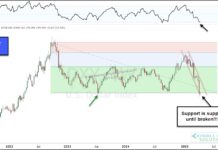Measuring price moves is the name of the game.
However, measuring price moves given recent context can add additional benefits to your trading performance.
At times, the market can get very quiet which can make a 1% price drop feel like a 10% price drop (think summer trading). At other times, a 10% price drop can feel like a 1% price drop (think 2008). This is a driving force in why I often prefer to view price moves in standardized form and expressed as “sigma” moves. A sigma score basically tells you how many standard deviations can fit between the mean and the current price move. To calculate sigma you simply subtract the mean from the underlying value and then divide that difference by the standard deviation.
Sigma = (X – Mean) / Stdev
In our case we will have X = the natural log of the one bar price change or log(close[t] / close[t-1])
The astute reader would question the lookback period used to calculate the mean and standard deviation of X used in our sigma calculation, and that brings us to a very unique indicator I often view.
I personally like to track the rolling window of one month (22 trading days) and one year (252 trading days). I then like to compare the one month sigma score of price changes to the one year sigma score of price changes. This gives an indication of how current volatility compares to more long-term volatility.
Below is a plot of the sigma score calculated on a rolling monthly basis and on a rolling yearly basis. You can see the monthly sigma scores stay “bounded” between -4 and +4 whereas the yearly sigma scores vary a tad more.
All of this is great, but how can we use this and why am I telling you about this…
Well when the monthly sigma minus the yearly sigma difference becomes greater than 1.5 we start to identify some key trading periods or moments in the S&P 500. For example, the instances where the difference between the monthly and yearly sigma reach 1.5 or more include the peak in 2007, the bottom in 2008, the flash crash in 2010, the European Debt Crisis of 2011, and the ETF meltdown of 2015.
ALSO READ: 3 Simple Ways To Reduce The Risk Of Curve-Fitting
Yesterday, May 17, was a significant down move but we are not near “significant” moments in history (yet) as the yearly sigma score stays subdued. This is definitely something to keep an eye on if this volatility persists throughout the summer.
Over at Build Alpha, I produce software that automatically creates systematic trading and investing strategies, allows the validation and testing of each strategy, and generates exportable and executable code for each strategy – no programming necessary.
Twitter: @DBurgh
No position in any of the mentioned securities at the time of publication. Any opinions expressed herein are solely those of the author, and do not in any way represent the views or opinions of any other person or entity.








